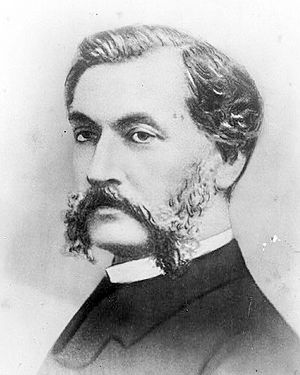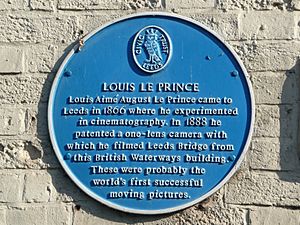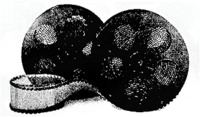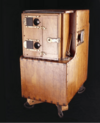Louis Le Prince facts for kids
Quick facts for kids
Louis Le Prince
|
|
|---|---|

Le Prince c. 1885
|
|
| Born |
Louis Aimé Augustin Le Prince
28 August 1841 |
| Disappeared | 16 September 1890 Dijon, France |
| Status | Declared dead on 16 September 1897 (aged 56) |
| Occupation | Artist, art teacher, inventor |
| Spouse(s) |
Elizabeth Le Prince-Whitley
(m. 1869) |
Louis Aimé Augustin Le Prince (born August 28, 1841 – disappeared September 16, 1890) was a French artist and inventor. Many people call him the "Father of Cinematography" (the art of making movies). He was likely the first person to film a moving picture using a single-lens camera and a strip of paper film.
Le Prince worked in the United Kingdom and the United States. His movie experiments ended in 1888 in Leeds, England. In October 1888, he filmed his family in Roundhay Garden and his son playing the accordion. He used his special single-lens camera and paper film. He also filmed Leeds Bridge later on. His work was ahead of other inventors at the time.
Sadly, Le Prince was never able to show his camera publicly in the US. He mysteriously vanished on September 16, 1890, after boarding a train. Many theories exist about what happened to him.
Contents
Early Life and Learning
Louis Le Prince was born on August 28, 1841, in Metz, France. His family called him "Augustin." Later, English friends called him "Gus." His father was a major in the French Army.
When Le Prince was young, he spent time in the studio of Louis Daguerre. Daguerre was a pioneer in photography. Le Prince may have learned about photography and chemistry from him. He later studied painting in Paris and chemistry at Leipzig University. This education helped him with his future inventions.
His Work and Inventions
Le Prince moved to Leeds, England, in 1866. He joined a company called Whitley Partners. In 1869, he married Elizabeth Whitley, who was also a talented artist. During their honeymoon in Paris, Le Prince was fascinated by a magic show. It showed moving transparent figures, possibly using mirrors.
Le Prince and his wife started an art school called the Leeds Technical School of Art. They became famous for putting colored photographs onto metal and pottery. They even made portraits of Queen Victoria and Prime Minister William Ewart Gladstone. These portraits were placed in a time capsule at Cleopatra's Needle in London.
In 1881, Le Prince went to the United States. He managed a group of French artists who created large panoramas (huge paintings). These paintings, often of famous battles, were shown in New York City, Washington, D.C., and Chicago.
During this time, he started experimenting with "moving" photographs. He designed a camera with sixteen lenses. This was his first patented invention. This camera could capture motion, but it wasn't perfect. Each lens photographed the subject from a slightly different angle. This would make the image jump if it were projected.
Le Prince returned to Leeds in May 1887. In 1888, he built a single-lens camera. He used this camera in his workshop at 160 Woodhouse Lane, Leeds. On October 14, 1888, he used it to film Roundhay Garden Scene. He also filmed his son Adolphe playing the accordion. Later, he filmed traffic and people crossing Leeds Bridge. This film was shot from a shop called Hicks the Ironmongers. Today, a special Blue plaque marks this spot.
His Mysterious Disappearance
In September 1890, Le Prince was getting ready to go to the United States. He planned to show his work publicly there and join his family. Before that, he decided to visit his brother in Dijon, France.
On September 16, he took a train to Paris. However, he took a later train than planned, and his friends missed him in Paris. No one in his family or friends ever saw him again. His brother was the last person to see him at the Dijon station. The French police and Scotland Yard searched for him, but they never found him.
Le Prince was officially declared dead in 1897.
Many theories have been suggested about his disappearance:
- Patent Wars: Some people believe he was killed because of his inventions. They think someone wanted to stop him from patenting his projector. His family suspected Thomas Edison was involved because of legal battles over film patents.
- Family Reasons: Another idea is that Le Prince chose to disappear because of money problems or family issues.
- Murder for Money: Some believe he was murdered. They argue that if he wanted to disappear, he could have done it earlier. This theory suggests he never even got on the train in Dijon.
Cameras and Patents
On January 10, 1888, Le Prince received an American patent for a 16-lens device. He said it could be both a camera (which he called "the receiver") and a projector (which he called "the deliverer"). He also got a similar patent in Great Britain. This patent mentioned a single-lens system, but it wasn't fully explained.
On October 10, 1888, he added more details to his British patent. Four days later, on October 14, Le Prince used his single-lens camera to film Roundhay Garden Scene. From 1889 to 1890, he worked with a mechanic named James Longley. They built different projectors with one, two, three, and sixteen lenses.
People close to Le Prince said he projected his first films in his workshop. But he never showed them to anyone outside his family and close friends. He planned a public show in New York City in September 1890, but he vanished before he could do it.
How He Is Remembered
Le Prince's achievements were amazing, but his work was mostly forgotten until the 1920s. This is because he disappeared before he could publicly show his invention.
In the US, Thomas Edison is often credited as the inventor of cinema. In France, the Lumière Brothers are seen as the inventors of the Cinématographe.
However, in Leeds, England, Le Prince is celebrated as a local hero. On December 12, 1930, a bronze plaque was placed at 160 Woodhouse Lane. This was Le Prince's old workshop. In 2003, the University named its Centre for Cinema, Photography and Television after him. His workshop is now part of the Leeds Beckett University complex. A blue plaque there remembers his work. You can also see copies of his films at the Armley Mills Industrial Museum in Leeds.
In France, a group called L'Association des Amis de Le Prince (Association of Le Prince's Friends) was created to honor him.
Many films and books have been made about Le Prince:
- In 1990, Christopher Rawlence wrote The Missing Reel. He also made a TV show about Le Prince's life.
- In 1992, Japanese filmmaker Mamoru Oshii made a film called Talking Head. It honored people like Le Prince who had sad endings in film history.
- In 2013, a documentary called The First Film was made. It shared new information about Le Prince's life and inventions. It was filmed in England, France, and the United States. Le Prince's great-great-granddaughter, Laurie Snyder, even appeared in the film.
Le Prince's Cameras and Projectors
His Remaining Films
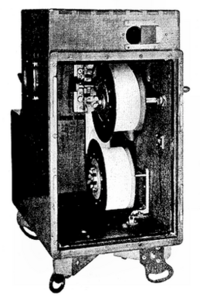
Le Prince's single-lens camera was used to shoot his films. The surviving films include two scenes from his wife's family home in Roundhay, and one of Leeds Bridge.
Forty years later, Le Prince's daughter, Marie, gave his remaining equipment to the Science Museum in London. In 1931, workers made photographic copies from paper prints Marie provided. In 1999, these copies were turned into digital videos. The Roundhay Garden film was thought to be shot at 12 frames per second (fps). Leeds Bridge was thought to be 20 fps. However, modern analysis suggests both films were shot at about 7 fps.
All available versions of these films come from materials kept at the National Science and Media Museum.
Man Walking Around a Corner (16-Lens Camera)
The only existing images from Le Prince's 16-lens camera show a man walking around a corner. These were likely shot onto a single glass plate, which has since broken. A French film historian, Jacques Pfend, believes these images were taken in Paris. Le Prince sent eight images of his mechanic running to his wife in a letter dated August 18, 1887. This suggests it was an important camera test. Some images were too bright, but Le Prince later fixed this problem.
Roundhay Garden Scene (Single-Lens Camera MkII)
The 1931 copy of Roundhay Garden has 20 frames. The frames seem to have been printed backward from the original. The film's damaged edge causes some distortion. This scene was filmed in his father-in-law's garden in Roundhay on October 14, 1888. The digital version plays at 24 frames per second, making the action look faster than it was. The original film was likely shot at 7 frames per second.
Traffic Crossing Leeds Bridge (Single-Lens Camera MkII)
Louis Le Prince filmed traffic crossing Leeds Bridge. He filmed it from a shop called Hicks the Ironmongers.
The oldest copy of this film is from 1923. A longer version is from 1931. Le Prince's son, Adolphe, who helped film it, said it was shot at 20 frames per second. However, the digital version plays at 10 frames per second. Like the Roundhay Garden film, it looks sped up. The original film was probably shot at 7 frames per second. This matches what his assistant, James Longley, said about the projector's top speed.
Accordion Player (Single-Lens Camera MkII)
The last remaining film from Le Prince's single-lens camera shows Adolphe Le Prince playing an diatonic button accordion. It was filmed on the steps of Joseph Whitley's house, Louis's father-in-law. It might have been filmed on the same day as Roundhay Garden because the camera position and Adolphe's clothes are similar. The National Science and Media Museum has not updated this film. An amateur video of the first 17 frames can be seen . The film seems to run at 5-6 frames per second.
See also
 In Spanish: Louis Le Prince para niños
In Spanish: Louis Le Prince para niños
- List of people who disappeared
- Roundhay Garden Scene


